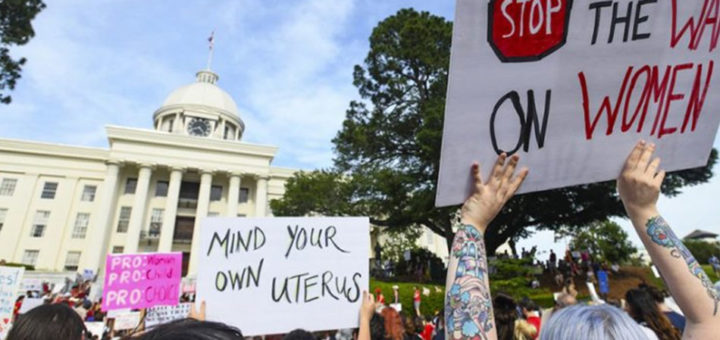Anti-abortion laws in America recently, have taken the world by a storm. Abortion has been legal in America since the 1973. Roe v. Wade ruling provided access to safe and legal abortions as a constitutional right. Right from the beginning, anti-abortions groups have continuously attempted to undermine this ruling. In light of this, following Georgia, Ohio, Mississippi and Kentucky, the near total ban in Alabama has been the most extreme and sweeping law that has been passed in recent memory. Challenging the constitution, anti-abortion politicians have, once again, highlighted how women are undermined and not even included in the policy making decisions, especially when the law is about the bodies of the women.
Abortion has been legal in America since the 1973. Roe v. Wade ruling provided access to safe and legal abortions as a constitutional right … the near total ban in Alabama has been the most extreme and sweeping law that has been passed in recent memory.”
The law not only bans all abortion, at any stage of pregnancy, with no exceptions for rape, incest or fetal viability, this would also see doctors who perform an abortion facing up to 99 years in prison.
Fact: THIS IS 89 MORE YEARS THAN SOMEONE CONVICTED OF RAPE.
After Alabama, Louisiana and Missouri soon followed with severe bans on abortion after six and eight weeks respectively. In contrast to this drive to ban or heavily limit options for abortion, the Democratic-led states have made a conscious decision to bring abortion to the forefront and make rights, safe abortion avenues and making it more accessible. This year Illinois became the third state, after New York and Vermont, to ensure that abortion remains legal even if the Supreme Court overturns the Roe v. Wade ruling.
The proposition of this bill had more than 500 #StopTheBans demonstrations spearheaded by several abortion rights groups and liberal organizations including American Civil Liberties Union (ACLU), the Women’s March, Planned Parenthood and the National Abortion and Reproductive Rights Action League (NARAL). Taking the streets with slogans screaming “Abortion is healthcare. Abortion is a right.” The fact that 25 men decided that they can make a law that directly questions not only the democratic rights of the women, but also questions their own understanding of their biology and strips them of planned parenthood entirely, is what the people have been protesting against.
Taking the streets with slogans screaming “Abortion is healthcare. Abortion is a right.” The fact that 25 men decided that they can make a law that directly questions their democratic rights and their own understanding of their biology is what people have been protesting against”
This wave of laws and amendments has forced women to come out and express why it has to be a decision that only they should make, and it has also intrinsically linked abortion to politics and what has become obvious is the lack of women policy makers and a lack of understanding of women’s issues.


Protestors participate in a rally on May 19, 2019 in Montgomery, Alabama. (Photo: Getty Images)
When you look at India, before 1971, abortion was a criminal offence under Section 312 of the Indian Penal Code, except in cases when it was necessary to save the woman’s live, labelling it as deliberately “causing miscarriage”. After the Medical Termination of Pregnancy Bill was passed in 1971, this allowed for stipulations such as health risk, possibility of substantial risk of serious physical handicap to the child, rape and risk for the mental health of the woman and made abortion available up to 20 weeks of gestation. Despite this, according to an article by The Lancet Global Health , it is estimated that 15.6 million abortions take place in India every year, and a majority of these are unsafe abortions. Unsafe abortion is the third largest cause of maternal morality leading to the death of 10 women each day. There’s also the fact that even though abortions are supposed to be legal, accessibility wise abortion clinics have been decreasing and in anti-choice states they are often not even covered by state or private health insurance. In India, we also have the stigma attached to abortion, especially when it comes to unmarried and underage women seeking access to safe abortions.
“It is estimated that 15.6 million abortions take place in India every year, and a majority of these are unsafe abortions. Unsafe abortion is the third largest cause of maternal morality leading to the death of 10 women each day.”
Seeing the rise of unsafe abortion seekers and the result, the Government took cognizance of the challenges faced by women and proposed four major amendments to the MTP law:
- To increase the base of legal MTP providers and ensure better access to safe and legal abortions.
- To increase the gestation period. This amendment was proposed on the basis that it takes more than the initial 20 weeks for medical practitioners to detect severe fetal abnormalities.
- Increasing access to legal abortion services for women
- Changing the indication to include unmarried women and to make more women aware of what MTP rights they have access to.
Despite the proposition of these amendments, the most important point raised was the gestation period. Appealed for by rape and sexual assault victims, this area specially needs amendment because the victims of any kind of sexual abuse might not discover the unwanted pregnancy till 24 weeks at least. Due to this negative aura that has been created around unwanted pregnancies and the idea of abortion as murder,what becomes apparent is the lack of female presence and female’s perspective when it comes to making laws about women’s bodies and their choices in our country. To challenge this notion, Dr. Shashi Tharoor, in his Women’s Sexual, Reproductive and Menstrual Rights Bill, 2018, proposed that instead of being called the Medical Termination of Pregnancy Act 1971, it should now be known as Legal Termination of Pregnancy Act so there is no mistake of understanding that the woman herself holds autonomy over her body and decisions related to her body. As a first step towards realizing women’s rights and respecting the their choice regarding sexual intercourse, menstrual health and unplanned or forced pregnancies, the Bill raises a strong voice in favor of women’s sexual autonomy, menstrual hygiene and abortion rights. There’s an apparent and glaring divide between men and women, and to have policy makers who will never actually experience the changes of pregnancy, what is needed the most is the inclusion for female policy makers, health care providers and even mobilization to educate as to how unsafe illegal abortions can be.
Due to this negative aura that has been created around unwanted pregnancies and the idea of abortion as murder,what becomes apparent is the lack of female presence and female’s perspective when it comes to making laws about women’s bodies and their choices in our country.
Photo: https://www.thelancet.com/journals/langlo/article/PIIS2214-109X(17)30453-9/fulltext





